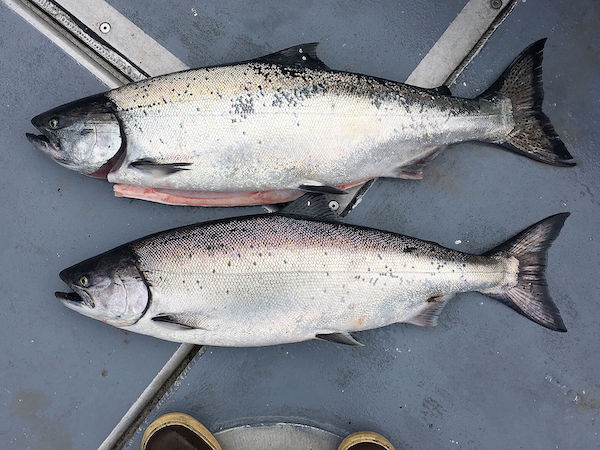forum
library
tutorial
contact

The Case of the
Disappearing Chinook Salmon
by Editorial Board
Capital Press, November 16, 2020
|
the film forum library tutorial contact |

|
The Case of the
by Editorial Board
|
This study appears to call into question the assumption that
four Snake River dams are to blame for the struggling chinook populations.
 Scientists know a lot about West Coast chinook salmon and the rivers where they spawn before their progeny head downstream to the open ocean.
Scientists know a lot about West Coast chinook salmon and the rivers where they spawn before their progeny head downstream to the open ocean.
What happens during those two to three years in the North Pacific is less well-known and, in fact, may hold the key to the survival of all of the region's chinook.
For decades, fisheries biologists have closely studied the chinook, which is prized by the commercial and sports fishing fleets -- so much so that they are known as "king" salmon in Alaska for their high value.
For example, at Seattle's Pike Place Market, the prices for whole chinook salmon range from $14.99 to $37.50 a pound. That makes a single 40-pound chinook worth upwards of $1,500 at retail.
Chinooks have been tagged and counted and hauled over and around dams to increase their survival rates. For years, scientists have assumed the numbers of chinooks returning from the ocean to spawn have been decreasing because of the dams on major rivers and other impediments such as culverts on smaller rivers and streams.
But a new study poses a question for which fisheries biologists and managers appear not to have an answer: Why are chinook salmon returns decreasing not only in rivers that have dams but also in those that don't?
That's an important question. It challenges many of the assumptions that scientists and activists have made, and even makes one wonder whether dams are the problem at all.
The study, by David Warren Welch, Aswea Dawn Porter and Erin Leann Rechisky of Kintama Research Services in Nanaimo, British Columbia, found that the returns of chinook salmon in rivers and streams along the Strait of Georgia were falling. The strait is between Vancouver Island and mainland British Columbia.
Problems faced by the southern population of orcas, which feed primarily on chinook salmon, would appear to back up that observation despite the constant chatter that the Snake River dams are the problem.
But the case of the disappearing chinook is even more mysterious.
"We discovered that chinook survival in many rivers of the Strait of Georgia region had fallen to levels well below those reported for Snake River chinook," the authors wrote.
They put together a study and found that, sure enough, all along the West Coast of the U.S. and Canada and across Alaska, chinook populations are shrinking by two-thirds of previous levels. Even more curious: nearly all of those salmon rivers are pristine, with no dams or other impediments.
This begs the question: What is going on here, and why? This study appears to call into question the assumption that four Snake River dams are to blame for the struggling chinook populations.
Activists and a few politicians say they are ready to sacrifice those dams to "save" the salmon.
This recent study shows that researchers have a lot more work to do before those -- or any other -- dams are sacrificed.
It would be folly to destroy the region's river transportation system, irrigation system, power generation and economy and still not help the chinook.
learn more on topics covered in the film
see the video
read the script
learn the songs
discussion forum
